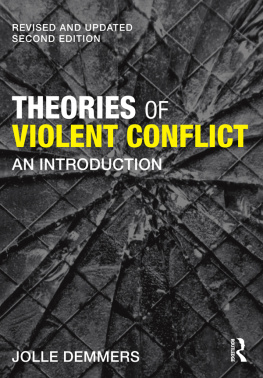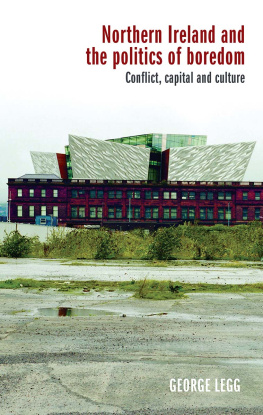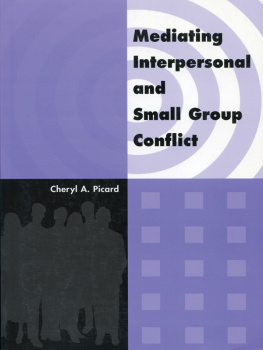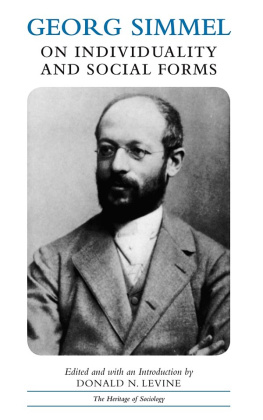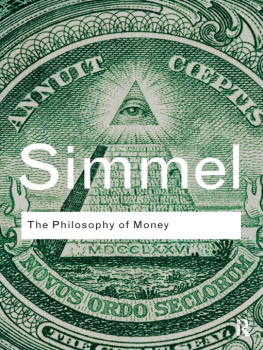George Simmel - Conflict and the web of group affiliations
Here you can read online George Simmel - Conflict and the web of group affiliations full text of the book (entire story) in english for free. Download pdf and epub, get meaning, cover and reviews about this ebook. City: Place of publication not identified, year: 2014, publisher: Free Press, genre: Religion. Description of the work, (preface) as well as reviews are available. Best literature library LitArk.com created for fans of good reading and offers a wide selection of genres:
Romance novel
Science fiction
Adventure
Detective
Science
History
Home and family
Prose
Art
Politics
Computer
Non-fiction
Religion
Business
Children
Humor
Choose a favorite category and find really read worthwhile books. Enjoy immersion in the world of imagination, feel the emotions of the characters or learn something new for yourself, make an fascinating discovery.

- Book:Conflict and the web of group affiliations
- Author:
- Publisher:Free Press
- Genre:
- Year:2014
- City:Place of publication not identified
- Rating:5 / 5
- Favourites:Add to favourites
- Your mark:
- 100
- 1
- 2
- 3
- 4
- 5
Conflict and the web of group affiliations: summary, description and annotation
We offer to read an annotation, description, summary or preface (depends on what the author of the book "Conflict and the web of group affiliations" wrote himself). If you haven't found the necessary information about the book — write in the comments, we will try to find it.
Conflict and the web of group affiliations — read online for free the complete book (whole text) full work
Below is the text of the book, divided by pages. System saving the place of the last page read, allows you to conveniently read the book "Conflict and the web of group affiliations" online for free, without having to search again every time where you left off. Put a bookmark, and you can go to the page where you finished reading at any time.
Font size:
Interval:
Bookmark:
GEORG SIMMEL
Conflict
AND
The Web of Group-Affiliations
Group-Affiliations
TRANSLATED BY REINHARD BENDIX
Conflict,
TRANSLATED BY KURT H. WOLFF
GEORG SIMMEL
WITH A FOREWORD BY EVERETT C. HUGHES
THE FREE PRESS
New York London Toronto Sydney Singapore

THE FREE PRESS
1230 Avenue of the Americas
New York, NY 10020
www.SimonandSchuster.com
Copyright 1955 by The Free Press
First Free Press Paperback Edition 1964
All rights reserved, including the right of reproduction in whole or in part in any form.
T HE F REE P RESS and colophon are trademarks of Simon & Schuster Inc.
Manufactured in the United States of America
20 19 18 17 16 15 14
Library of Congress Catalog Card Number: 54-10671
ISBN 0-02-928840-1
eISBN: 978-1-451-60251-7
K URT H. W OLFF AND T HE F REE P RESS did American scholars a distinct service by translating and publishing important parts of the sociological work of Georg Simmel in a volume entitled The Sociology of Georg Simmel (1950). Reinhard Bendix has joined them in a further service by making an additional chapter of Simmels Soziologie available. Their contribution is made the greater by the fact that those Americans whose mother-tongue is English (including those among them whose mothers tongue was not English) are extremely loath to learn other languages. Translations from other languages are also relatively few and are slow in appearing. If we should now stop the stream of immigrants of some measure of higher learning acquired in other languages, our linguistic isolation may become even more embarrassing than it is now. We are already peculiarly dependent upon translations.
The major intellectual danger of this dependence is that we Americans will often simply not know of work written in other languages. A minor danger is that we may take the translated part for the whole of a mans work. This second risk is much reduced, for Simmels work, by the appearance of the crucial chapters which make up this volume. As a matter of fact, Simmels work is less subject to this danger than is that of many scholars. For his style of thought shines clearly through in nearly every piece of his writing, even in many of the smaller essays which he wrote for magazines and for the feature sections of newspapers. But if less is lost by eading only a small part of his work, it does not follow that there is less gain in reading more. Quite the contrary, for his pages are so full of brilliant insights, and of applications of his style of analysis to concrete cases, that the reward for reading on and on is especially great.
One might apply to Simmels work his own dialectic of form and content. The basic form of his thought is recognizable in almost any small part of his work, but it is elaborated in being applied to each new content. And since, as he says, content and form are relative terms, every new content enables him to raise the level of abstraction with which he conceives social forms; but the higher the level of abstraction, the richer the variety of contents suggested by the form and the greater the number of facets of social reality perceived through it. Simmels thought nearly completes its circle again and again; but just as the circle is about to be closed, his thought takes wing in some new arc that almost becomes another circle. This gives his work a tentative, never quite complete, which some mistake for an unsystematic, quality.
Critics of Simmel say that he never proves anything by empirical test. That is true. As his thought develops, he flashes an illustration before us; say, the Catholic clergy. The clergy gives him a model (ideal-type or pure case) of a social group which, although it draws its postulants from all classes and nations, is free of all complicating overlapping memberships. Celibacy frees the postulants from their past and keeps their present uncomplicated. The case is an example, and a stimulus to thought, not a demonstration. It may not even be a true example of the form he describes. But his case will suggest others which approximate the form in question; and approximations can be tested as absolutes never can be.
In Simmel, movement from pure model (form) to particular case (content) and back again is incomparably more rapid than in any other of the classic sociologists. The variety of both forms and contents presented for analysis and illustrations is correspondingly greater. If he is wrong in fact more often than others (I do not say that he is), it is because he alludes to a greater variety of fact, of times, places and circumstances. Until we can do much better than we now do at fitting data to the needs of insights and ideas (much of our present empirical ingenuity is exerted in exactly the opposite direction) we will do well to temper our criticism of Simmels fashion of illustrating his ideas by examples drawn from wide historical knowledge and great social sophistication rather than testing them by experiment or controlled observation.
The title of this volume is Conflict and The Web of Group-Affiliations. It might well have borne also the sub-title: Essays on Social Organization. For Simmel sees conflict as part of the dynamic by which some men are drawn together (and others, by the same token, driven away from each other) into those uneasy combinations which we call groups. The inter-weaving or, better, the entangling of social circles (group formation and group affiliations in Bendix translation) is viewed, in the same way, as part of the dynamic both of groups and of the individual personalities who compose them. Simmel is thus the Freud of the study of society. Instead of seeing change as disturbance of a naturally stable thing called society, he sees stability itself as some temporary (although it may long endure) balance among forces in interaction; and forces are by definition capable of being described only in terms of change. This is strikingly similar to what Freud did for the study of human personality. Like Freud, he has many intellectual children. Not all of them have that wisdom which makes them know their own father.
E VERETT C HERRINGTON H UGHES
TRANSLATED BY KURT H. WOLFF
The title of this essay is Der Streit. Streit is usually translated as quarrel, but has a broader meaning for Simmel; hence conflict seems better. The essay is Chapter 4 of Soziologie (1908); it is translated from the third edition of this work (1923; pp. 186-255). All sub-headings are supplied, as are passages in brackets. An earlier translation of a considerably different original by Albion W. Small (The Sociology of Conflict, The American Journal of Sociology, Vol. IX, 1904), has been examined, but is not the basis of the present rendition. For a fuller bibliographical reference to Smalls translation, see The Sociology of Georg Simmel, transl., ed., and with an introd. by Kurt H. Wolff (Glencoe, Illinois: The Free Press, 1950), p. lviii.Tr.
The Sociological Nature of Conflict
THE SOCIOLOGICAL SIGNIFICANCE of conflict (Kampf) has in principle never been disputed. Conflict is admitted to cause or modify interest groups, unifications, organizations. On the other hand, it may sound paradoxical in the common view if one asks whether irrespective of any phenomena that result from conflict or that accompany it, it itself is a form of sociation. At first glance, this sounds like a rhetorical question. If every interaction among men is a sociation, conflictafter all one of the most vivid interactions, which, furthermore, cannot possibly be carried on by one individual alonemust certainly be considered as sociation. And in fact,
Next pageFont size:
Interval:
Bookmark:
Similar books «Conflict and the web of group affiliations»
Look at similar books to Conflict and the web of group affiliations. We have selected literature similar in name and meaning in the hope of providing readers with more options to find new, interesting, not yet read works.
Discussion, reviews of the book Conflict and the web of group affiliations and just readers' own opinions. Leave your comments, write what you think about the work, its meaning or the main characters. Specify what exactly you liked and what you didn't like, and why you think so.

